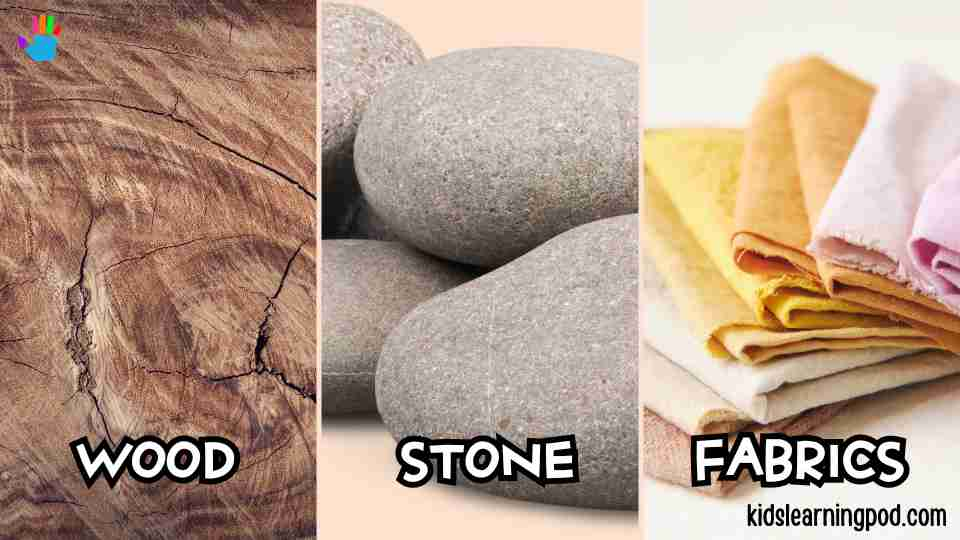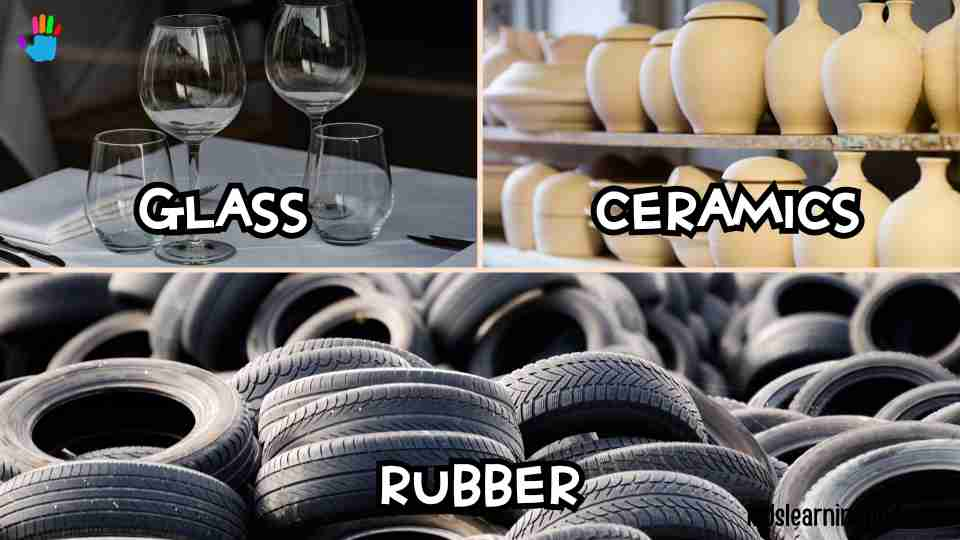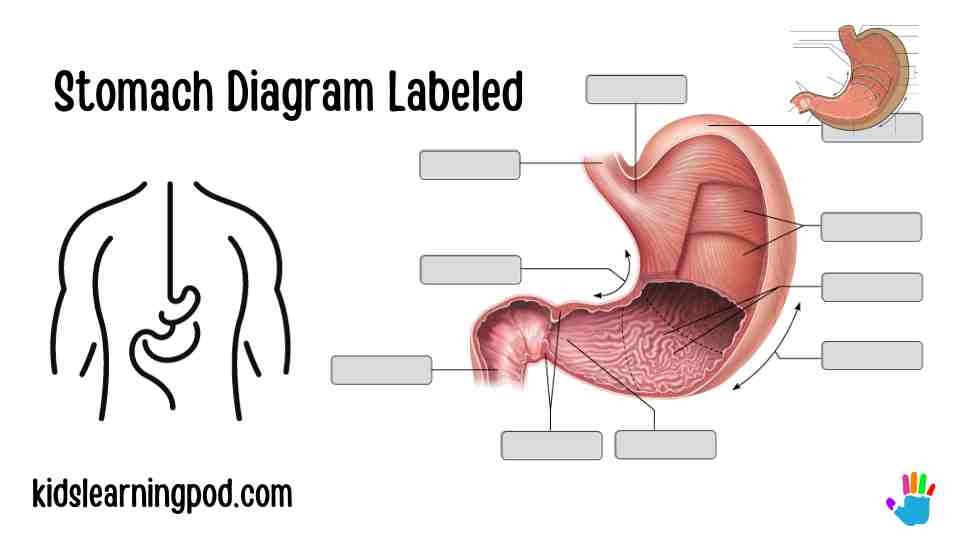Types of Materials and Their Properties are an important aspect for children to learn about. The stuff we use to create something is called a material. Like, think about a school desk. It can be made from wood, plastic, metal, or a mix of these.
When we plan and make something, we need to pick the right material. Materials have traits like how strong, what color, and how hard they are. We have to think about these traits. Things like how much it costs and if it’s easy to find can also matter.
Materials can be either natural or made by people. They can come from things that are alive or things that are not alive. A material that hasn’t been changed yet is called a “raw material.” Some natural materials will eventually run out, so we need to use them carefully and replace them when possible. This is what we mean by using natural resources sustainably.
Materials made from Living Things
Things like wood, paper, and cardboard come from trees. Leather comes from the skin of cows, wool from sheep, and cotton from plants. Mother-of-pearl is a shiny and colorful stuff used for jewelry or decorating things. It’s found inside certain shells.
Materials made from Nonliving Things
Metals and valuable gems like diamonds are taken from rocks in the ground. Chalk, clay, coal, and sand are also materials that come from things that were never alive.
Some materials are a mix of living and nonliving things. Soil, for instance, is made up of tiny living organisms, dead plants, small rocks, air, and water.
Types of Materials and Their Properties in general
Materials have characteristics that describe them. These characteristics are important when deciding if a material will work for a particular job. Materials can be soft or hard, flexible (bendable) or rigid (stiff), transparent (see-through) or opaque (not see-through), rough or smooth, shiny or dull.
For instance, let’s take glass. It’s see-through, hard, and smooth. It can be shaped into different forms during manufacturing, it’s waterproof, but it can break easily. We use it for making things like windows, containers, eyeglasses, and more.
Plastic is another kind of material. It’s strong, waterproof, and long-lasting (durable). It can be see-through or not, depending on how it’s made. We use it to create everyday items like bottles, bags, toys, and computer equipment.
Download Worksheets of Types of Materials and Their Properties pdf
In this post we will learn about types of materials and Their Properties. There are different types of materials available in this world and kids need to know about them from an early age. Parents especially homeschooling their kids must teach them about types of materials from an early age. Materials are what make this world and there are a lot of types of them around us.
Metals: The Sturdy Ones!
Metals are like the superheroes of the material world. They are strong, durable, and can conduct electricity. Think of your favorite toy car or the kitchen utensils – many of them are made of metals. They are shiny, heavy, and can be molded into various shapes.
Metals are essential materials in manufacturing and construction. Common examples include iron, aluminum, copper, zinc, tin, and lead. Many metals are used in alloy form, which involves combining two or more metals or mixing a metal with nonmetallic materials to achieve specific characteristics, such as increased hardness or strength. For instance, steel is an alloy of iron and carbon. Metals generally share three key characteristics: they have a lustrous appearance when cut or scratched, are malleable and can be shaped with the right heat and force, and they conduct heat and electricity. However, individual metals exhibit unique properties, making them suitable for various applications.
Plastics: A Versatile Material
Plastics are incredibly versatile materials. They can be hard as a rock or soft as a pillow. Plastic bottles, toys, and even your school backpack are made of different types of plastics. They are lightweight, colorful, and can be easily shaped into a variety of forms.
Plastics come in various forms and are used to make a wide range of products. Plastic molecules consist of long chains known as polymers. Plastics can be categorized into thermoplastics, which can be heated and reshaped multiple times, and thermoset plastics, which can only be heated and shaped once. Plastics are cost-effective, strong, resistant to electricity and water, and durable. However, their durability is a concern due to their long decomposition times. Recycling thermoplastics is more feasible than recycling thermoset plastics.
Wood: Nature’s Gift
Wood is a natural material that has been used for centuries. It’s strong, yet it has a warm and earthy feel. Your favorite wooden toys or furniture are made from this wonderful material. Wood can be carved, painted, and is excellent for building.
Plastics come in various forms and are used to make a wide range of products. Plastic molecules consist of long chains known as polymers. Plastics can be categorized into thermoplastics, which can be heated and reshaped multiple times, and thermoset plastics, which can only be heated and shaped once. Plastics are cost-effective, strong, resistant to electricity and water, and durable. However, their durability is a concern due to their long decomposition times. Recycling thermoplastics is more feasible than recycling thermoset plastics.
Stone: Makes the Foundations
While reading about types of materials and their properties think of grand castles or ancient temples, they were built with stone. Stone is a solid and durable material. It can be smooth like marble or rough like granite. It withstands the test of time and adds a majestic touch to architecture.
Stones, often seen as solid and unyielding, have been a fundamental part of human history and culture. These natural, hard substances are typically composed of minerals, and they have been used by humans for various purposes for thousands of years. From prehistoric tools and weapons made from flint and obsidian to the enduring monuments like the Egyptian pyramids, stones have left an indelible mark on human civilization. They serve as construction materials for buildings, roads, and bridges, and are also used for sculptures, gravestones, and jewelry.
The rich variety of colors and textures in different types of stone, like granite, marble, or slate, makes them both practical and aesthetically pleasing choices for numerous applications. Stones have also been valued for their symbolism and spiritual significance in various cultures. Whether as a foundation for civilization, an artistic medium, or a symbol of permanence, stones continue to hold a prominent place in our lives.
Textiles: Cover and Comfort
Textiles encompass fibers, yarns, and fabrics made from materials like wool, cotton, or synthetic fibers like polyester. Textiles are essential for producing clothing, carpets, and numerous other products. Textile fibers must meet specific criteria like strength, flexibility, elasticity, and durability to be spun into yarn or woven into fabrics. Different types of fibers offer various properties, such as warmth, durability, softness, and comfort, and sometimes a combination of fibers is used to achieve the desired textile characteristics.
Your cozy blankets, soft clothes, and even the curtains in your room are made from fabrics. Fabrics come in various types, from cotton to silk. They are soft, colorful, and perfect for keeping you warm and stylish.

Glass: The Transparent One
Glass is a unique material because it’s see-through. You can find glass in your windows, drinking glasses, and even your smartphone screen. It’s fragile, so handle it with care, but it allows you to see the world outside while staying protected.
Glass is primarily composed of sand, specifically silicon dioxide, heated to a high temperature and then cooled to form a transparent solid. Common glass, such as soda-lime-silica glass, contains sand along with soda ash to lower the melting point and limestone to prevent water solubility. Glass possesses properties like transparency, heat resistance, and, despite its appearance, it can be quite hard when in thicker forms. Different ingredients can be added during glass production to give it unique characteristics, such as boron oxide for oven-proof glass or lead oxide for decorative crystal objects.
Ceramics: The Artistic Creations
Ceramics are like pieces of art. They include delicate porcelain dishes, colorful tiles, and even pottery. Ceramics are known for their beauty and intricate designs. They can be fragile, so they are often used for decorative purposes.
Ceramics are inorganic solids made by heating materials like clay and sand at high temperatures. Examples of ceramics include bricks, tiles, and concrete. Ceramics are known for their hardness, high melting point, resistance to chemical corrosion, and their ability to insulate against heat and electricity. Some ceramics, like glass and porcelain, can be brittle but are exceptionally durable.
Rubber: Bouncy Bouncy Bouncy
Rubber is the material that makes your balls bounce and your tires grip the road. It’s flexible, stretchy, and great for absorbing shocks. Rubber boots and erasers are just a couple of examples of how rubber is used.
Rubber can be natural or synthetic. Natural rubber is derived from latex produced by plants, primarily the rubber tree (Hevea brasiliensis). It is processed by chewing, adding chemicals, squeezing, stretching, and heating to create the versatile material. Synthetic rubber replicates many properties of natural rubber and is used in various applications, such as tires, hoses, belts, and flooring. Natural rubber is stretchy, durable, and waterproof, while synthetic rubber is made through chemical processes and exhibits similar characteristics.
Rocks and Minerals
Nature provides us with some incredible materials too. Rocks like granite and limestone are used in construction, while minerals like gold and silver are precious and used to make jewelry.
Rocks and minerals are the building blocks of the Earth’s crust, and they play a crucial role in our daily lives. Rocks are composed of various minerals, and their formation processes are closely tied to geological forces and time scales. Minerals, on the other hand, are naturally occurring inorganic substances with distinct chemical compositions and crystal structures. They can be found in a wide range of colors, shapes, and sizes, and their properties are essential for various applications.
For instance, quartz is used in electronic devices, while limestone is a primary component in construction materials like cement and concrete. Additionally, rocks and minerals provide valuable insights into Earth’s history and geological processes. Geologists study them to understand Earth’s evolution, as well as to discover valuable resources such as ores, gemstones, and fossil fuels. In sum, rocks and minerals are integral components of our world, contributing to both our understanding of the planet and our daily lives.

Download Types of Materials and Their Properties pdf
Kindly Allow Pop ups to let the Download Begin!
Physical and Chemical Properties
Material types and their properties have characteristics that describe them. These characteristics are important when deciding if a material will work for a particular job. Materials can be soft or hard, flexible (bendable) or rigid (stiff), transparent (see-through) or opaque (not see-through), rough or smooth, shiny or dull.
For instance, let’s take glass. It’s see-through, hard, and smooth. It can be shaped into different forms during manufacturing, it’s waterproof, but it can break easily. We use it for making things like windows, containers, eyeglasses, and more.
Plastic is another kind of material. It’s strong, waterproof, and long-lasting (durable). It can be see-through or not, depending on how it’s made. We use it to create everyday items like bottles, bags, toys, and computer equipment.
Insulators and Conductors
Materials can be either insulators or conductors, and these terms are about how well a material lets heat or electricity move through it.
Thermal Insulators slow down the movement of heat. Think of fabrics, like polyester and wool, used in warm clothes. They trap warm air and prevent it from escaping, which keeps you warm.
Thermal Conductors, on the other hand, allow heat to move through them quickly. That’s why metals, like those used in cooking pots, are good at conducting heat.
For electricity, some materials, especially metals, are excellent at allowing electricity to flow through them. We call these electrical conductors. Materials that don’t let electricity pass through, like plastic and rubber, are called electrical insulators.
Material can change themselves – Types of Materials and Their Properties which are awesome in practical applications.
Materials often undergo changes, and these changes can be natural or caused by people. A material can go through either a physical or a chemical change.
Physical change: This happens when a material changes its form but remains the same substance. For example, if you snap a pencil in two, it changes its shape, but it’s still just a pencil. When you heat frozen water (ice), it turns into liquid water, but it’s still the same substance, which is water.
Chemical change: This is when a material transforms into a completely new substance. The tiny units of the material, called molecules, break apart and create new molecules. For instance, when wood burns, its molecules change to form new molecules like smoke and ash. When iron is exposed to oxygen and moisture for a long time, it changes into a new substance called iron oxide or rust. A chemical change cannot be reversed, meaning it’s permanent.
Physical and chemical changes can happen when materials are heated or cooled. They can also occur when materials are mixed together or separated from each other.
Effect of Heating and Cooling on Materials
Heating and cooling can have various effects on materials.
Heating:
- Expansion: When you heat most materials, they tend to expand, meaning they take up more space. This is why things like metal railroad tracks have gaps to allow for expansion in hot weather.
- Change in State: Heating can cause materials to change from one state to another. For example, when you heat ice, it turns into water, and further heating can turn water into steam.
- Chemical Reactions: High temperatures can trigger chemical reactions in some materials, leading to the formation of new substances. For instance, heating wood can cause it to burn and transform into ash and smoke.
Cooling:
- Contraction: Cooling typically causes materials to contract or shrink. This means they take up less space. For example, when a metal rod is cooled, it may become slightly shorter.
- Change in State: Cooling can also lead to state changes. For instance, when you cool water, it freezes and turns into ice.
- Strengthening: In some cases, cooling can make materials stronger and more rigid. This is often seen in metals and alloys when they are rapidly cooled from high temperatures, a process known as quenching.
Mixing Materials
Mixing different types of materials and their properties can lead to changes, and these changes can be either reversible or irreversible.
Compound Formation
When you mix two or more substances, and they combine to create a brand-new substance, it’s called a compound. Compounds are formed through chemical changes. For instance, when you mix cement powder and water, it creates a strong new material. Cement consists of multiple compounds, and these compounds can only be separated into their original elements through chemical processes.
Mixtures
When you mix two or more substances, and they don’t create a new substance, it’s called a mixture. Mixtures result from physical changes. For example, if you mix sand into a glass of water, the sand settles at the bottom. This is a physical change, and it can be reversed by straining the water from the mixture and letting the sand dry.
Solutions
Sometimes, when you mix two substances, they form a special kind of mixture known as a solution. This happens if the two substances stay evenly mixed. For instance, when you stir ordinary sugar into clean water, it dissolves and creates a solution. The tiny sugar molecules spread out evenly in the water, but the individual sugar molecules remain the same. Mixing sugar and water is a physical change because the sugar and water molecules don’t change. Like all mixtures, solutions can be separated. For example, the water in a sugar-water solution will eventually evaporate, changing from a liquid to a gas, and leaving the sugar behind.
The Environmental Impact of Material Sourcing
In recent times, people have realized that the way we find, use, and change materials can have long-lasting effects on the environment. Using materials in a way that doesn’t harm the environment is known as sustainable use.
Finding various types of materials and their properties, or sourcing them, can greatly impact the environment and people’s lives. For example, coltan is a material found underground in the forests of the Democratic Republic of the Congo, and it’s used in cell phones and computer parts. In the early 2000s, many became concerned about coltan mining. The people who extracted it worked in harsh conditions, but they did it because they needed the money. The mining also affected the animals in the forests, with gorillas and elephants losing their homes, and some were even killed by the miners for food.
Certain raw materials like oil, coal, and gas are limited on Earth’s surface. Once we use them up, they can’t be replaced. So, we’ll need to find alternative sources of energy.
Types of Materials and Their Properties like wood can be replaced, but this requires planting new trees. When we cut down forests, though, it means that other plants and animals living there lose their homes, often permanently. This has consequences for the overall ecosystem.
FAQs about Types of Materials and Their Properties
Q: Why do metals feel cold when you touch them?
A: Metals are good conductors of heat, which means they can quickly transfer the heat from your hand, making them feel cold.
Q: Are all plastics the same?
A: No, there are many types of plastics with different properties. Some are hard and rigid, while others are soft and flexible.
Q: How can you tell if something is made of wood or plastic?
A: Wood has a natural grain and is usually heavier than plastic. You can also try tapping it – wood will make a dull sound, while plastic will sound hollow.
Q: Why can’t you see through wood or metal like you can with glass?
A: Glass is transparent because its molecules are arranged differently, allowing light to pass through. In wood and metal, the molecules are packed more closely, blocking light.
Q: What’s the difference between ceramics and pottery?
A: Types of Materials and Their Properties depend upon what they are made of. Pottery is a type of ceramics. Ceramics is a broader category that includes pottery, porcelain, and other clay-based creations.
Q: How is rubber made?
A: Rubber is made from the latex sap of rubber trees. It’s processed and treated to become the bouncy material we know.
Learn about Types of Materials and Their Properties Now
Conclusion
We learned Types of Materials and Their Properties for kids, exploring metals, plastics, wood, stone, fabrics, glass, ceramics, rubber, and natural materials. These materials are the building blocks of our world, and understanding their properties enriches our knowledge of the world around us. Learn more about Type of Materials here.
So, next time you pick up your favorite toy or look out the window, remember that Types of Materials and Their Properties play a vital role in making it all possible. Keep your curiosity alive, and never stop exploring the wonders of science and the materials that shape our lives.





